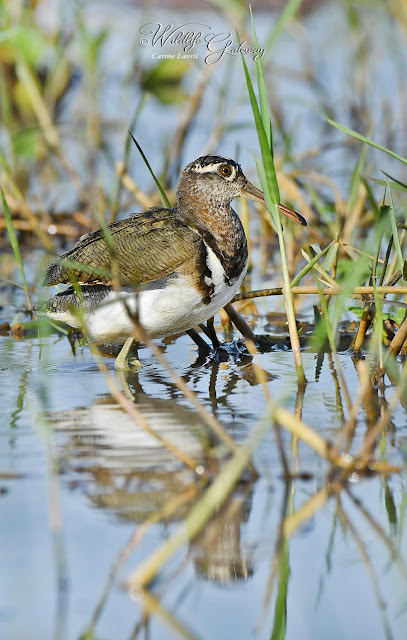 Lac de Baringo, Kenya
Lac de Baringo, KenyaSeule avec le "capitaine" du canoé et mon ami ornitho, je leur demande de me trouver cet oiseau difficile à observer, discret et furtif, s'envolant dès que nous étions à portée d'objectif! Nous y avons passé une matinée entière et j'ai fini par faire quelques clichés volés mais dans une lumière difficile. L'espèce est monotypique, de la famille des Rostratulidés contrairement à la Bécassine des marais ou la Bécasse des bois, membres de la famille des Scolopacidés. On la trouve dans les zones inondées où elle se nourrit de petits crustacés, de vers, d'insectes et d'escargots d'eau et de graines.
Alone with the canoe "captain" and my friend ornithologist, I ask them to find for me this difficult bird to observe, discreet and stealthy, flying off as soon as we were within target range! We spent an entire morning there and I ended up making a few shots but with a difficult light. The species, of the Rostratulidae family, is monotypical unlike the Marsh Snipe or the Woodcock, members of the Scolopacidae family.
It is found in flooded areas where it feeds on small crustaceans, worms, insects, and water and seed snails.
Dimorphism is pronounced between the two sexes: the female is more colorful and larger than the male.
Le dimorphisme est prononcé entre les deux sexes: la femelle est plus colorée et plus grande que le mâle.
Le mâle:




La femelle:




Pięknie pokazane .
RépondreSupprimerNunca me cansaré de ver tus bellísimas imágenes ¡feliz otoño!, querida Carine.
RépondreSupprimerextraordinaire ! je suis subjuguée par tes photos
RépondreSupprimerWelcome back to bloggerland, Carine. I've missed you, and I'm sure that many others have too!
RépondreSupprimerI didn't think that I had heard of this species before, and then realised that I had - as Painted Snipe. What beautiful birds! I think that the male is just as handsome as the female, even if less colourful. Thank you for persevering with your attempts which have allowed you to show us your delightful images.
Best wishes from UK. Take good care, and come back to bloggerland soon - - - Richard
Dearest Noushka,
RépondreSupprimerWow, for once the female is very bright colored compared to the male.
What an incredible bird and you took some great photos of it!
Sending you hugs,
Mariette
Hi Noushka.
RépondreSupprimerA beautiful bird.
Super nice photos.
Greeting from Patricia.
Pour une fois, c'est la femelle la plus chatoyante !
RépondreSupprimersuperbe rencontre en tous les cas
bonne journée
Your patience rewarded Carine. Most wonderful bird and photos.
RépondreSupprimerRegard,
Roos
Many thanks to you my faithful friends for your support and encouragements.
RépondreSupprimerMuchas gracias Belén por tu aliento, ma das la envidia de seguir!
Merci à tous et à toutes pour vos commentaires encourageants!
Beau challenge, réussi, et belles photos mais comment en serait-il autrement ? ;-)
RépondreSupprimerJoli travail Carine
Coucou Noushka, un bien bel oiseau et cela fait plaisir de voir que c'est la femelle qui est la plus colorée car c'est souvent le contraire. Merci pour ce beau partage.
RépondreSupprimerDouce fin de semaine.
Je t'embrasse
chatou
Bonjour Noushka,
RépondreSupprimerSuperbe reportage sur ces beaux oiseaux,la photo avec les ailes déployées est magnifique. Bravo pour la persévérance qui paie!
Excelente serie de esta curiosa avecilla.. :-)
RépondreSupprimer